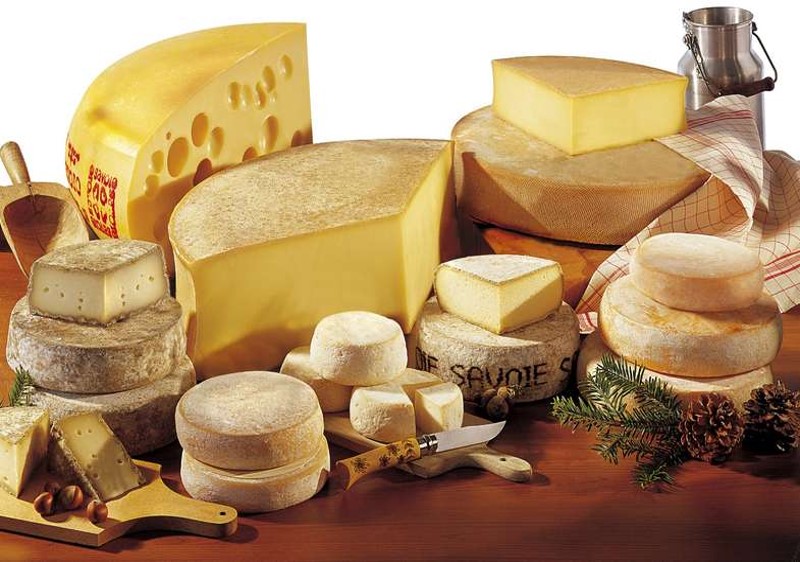
Savoy cheeses : The cheese de Savoy affirm a strong identity, linked to a "terroir" rich and varied. Savoie has more than 300 producers of farmhouse cheese and 60 collective cheese dairies.
Over the centuries, people have slowly modified their practices to improve the qualities of each cheese from Savoie. It is the great clearing of the Middle Ages that allowed men to use the mountain pastures of Savoy. At the same time, they transformed the milk into the largest possible cheeses, to facilitate storage and allow winter consumption. It is also to allow the manufacture of larger cheeses, and in particular theEmmental, which we see born, at the end of the XNUMXth century, fruit trees and processing cooperatives in each village of Savoie.
Today in 2020, there are still more than 1950 producers of milk (mainly organized in around a hundred cooperatives) and 60 processing workshops. The production on the farm or in the mountain pastures remains a feature of Savoie cheese, with more than 340 workshops.
Savoyard cheeses do not subject the milk to any treatment aimed at reducing the flore lactic before transformation (heat treatment, micro-filtration): we say that the cheeses are raw milk. The milk is processed very soon after milking or foaming (generally less than 24 hours).
Work in raw milk helps to conserve the microbial flora naturally present in milk: several dozen bacterial species will thus participate through their diversity in establishing their characteristics sensory. Cheese makers know how to use this microbial richness of raw milk, or by practicing a maturation on part of the milk, or by using sourdough selected from traditional products.
The production of Savoie cheese always includes a similar process: seeding, renneting, chipping, brewing, molding, pressing, salting, drying-refinement, but with adaptations to the times, temperatures and the helping hand that will form very different cheeses. They all have in common the manufacturing at raw milk, the presence of Man and the materials traditional.
For Savoie cheeses, this is the only method of preservation authorized, the freezing being strictly prohibited. The refiner uses all his know-how to enable the cheeses to reach maturity and let express the particularities resulting from the "terroir" and conveyed by raw milk.
In the Savoys, to make the most of thegrass available, the cows have to move from one pasture to another, sometimes on the slopes, on plots that can be far away going as far as the Alpine pastures. They must be able to be fed, summer and winter, mainly with grass or hay, while producing a rich milk to promote cheese processing.
The 3 main breeds present in Savoy perfectly meet these requirements, they are mountain breeds. Their adaptation to the area is all the more perfect as for two of them, the cradle of the breed is located in the Northern Alps (the third coming from the Jura, another famous cheese mountain).
The cradle of breed Abundance is of course the valley ofAbondance, and that of Tarentaise or Tarine, the valley of the Tarentaise.
Climatic and geographic constraints have strongly influenced the agricultural use of the territory in Savoy. The significant average altitude (1300 m), with steep slopes and mountain climatic conditions (significant cold and high rainfall) favors the growth of grass (90% of the useful agricultural area of Savoy is meadows, 310 Ha). Between the eleventh and the fifteenth century, the deforestation of the mountain forests of Savoy, encouraged by local and ecclesiastical authorities, gave rise to large areas intended for grazing herds. It was from this moment that the agriculture of Savoy turned towards the production and transformation of milk into cheese.
The mountain also provides very different situations, thus the altitude which varies from 210 m to 4810 m, the very diverse soils (limestone Pre-Alps or crystalline massifs) and the climatic conditions (more or less dry) give conditions of very different breeding and life. It is part of the differentiation of each terroir that makes the quality of the Savoie cheese board.
The Savoy territories have a tremendous diversity of resources. The high-altitude pastures and dairy breeds offer an exceptional natural richness, which gives Savoy cheeses their specificity. Beneficiaries of this privileged natural space, the actors of the cheese sectors are also its guarantors. Through practices adapted to the environment, they contribute to responsible management of the environment, in a process of sustainable development.
Floral or microbial biodiversity: an asset for cheese making in the Pays de Savoie.
In their production activity, the farmers and cheese makers of Savoie are confronted daily with the use and management of biodiversity, whether floral or microbial: in alpine pastures, alpacists use a great diversity of vegetation (resulting geological and climatic conditions and their pastoral practices), to organize their grazing circuit. They also take this diversity of lawns into account in their cheese-making practices.
When making cheese beaufort, the use of particular methods makes it possible to do away with commercial ferments, by "cultivating" the microbial diversity of cheese factories.

